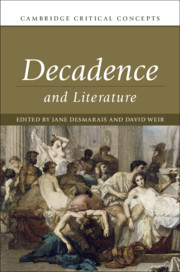Book contents
- Decadence and Literature
- Cambridge Critical Concepts
- Decadence and Literature
- Copyright page
- Dedication
- Contents
- Figures
- Contributors
- Acknowledgements
- Introduction
- Part I Origins
- Part II Developments
- Part III Applications
- Chapter 16 Decadence and Urban Geography
- Chapter 17 Socio-aesthetic Histories: Vienna 1900 and Weimar Berlin
- Chapter 18 Decadence and Cinema
- Chapter 19 Transnational Decadence
- Chapter 20 Decadence and Modernism
- Chapter 21 Modern Prophetic Poetry and the Decadence of Empires: From Kipling to Auden
- Chapter 22 The Gender of Decadence: Paris-Lesbos from the Fin de Siècle to the Interwar Era
- Chapter 23 Decadence and Popular Culture
- Select Bibliography
- Index
- References
Chapter 23 - Decadence and Popular Culture
from Part III - Applications
Published online by Cambridge University Press: 12 August 2019
- Decadence and Literature
- Cambridge Critical Concepts
- Decadence and Literature
- Copyright page
- Dedication
- Contents
- Figures
- Contributors
- Acknowledgements
- Introduction
- Part I Origins
- Part II Developments
- Part III Applications
- Chapter 16 Decadence and Urban Geography
- Chapter 17 Socio-aesthetic Histories: Vienna 1900 and Weimar Berlin
- Chapter 18 Decadence and Cinema
- Chapter 19 Transnational Decadence
- Chapter 20 Decadence and Modernism
- Chapter 21 Modern Prophetic Poetry and the Decadence of Empires: From Kipling to Auden
- Chapter 22 The Gender of Decadence: Paris-Lesbos from the Fin de Siècle to the Interwar Era
- Chapter 23 Decadence and Popular Culture
- Select Bibliography
- Index
- References
Summary
This chapter examines decadence in terms of the contemporary popular obsession with the practice of self-fashioning through dandyism, drag, or costume as a way of negotiating or overcoming social boundaries, often in a playfully transgressive manner. Glam rock stars of the 1970s represent a modern form of dandyism and camp self-expression, while the aesthetics of opulence and excess take on a more profound significance when considered in terms of social inequality in the drag ball culture of 1980s New York where the aspiration to be ‘real’ is enacted through costumes and cosmetics. Decadence in today’s celebrity culture is exemplified by Lady Gaga’s gender-bending pop performance art, and we can also observe a queer countercultural resistance to the mainstream using the same decadent paradoxes of beauty and decay, artifice and reality. The ‘cult of the self’ may seem superficial, but the process of self-fashioning through clothing and makeup is in fact a process of self-acceptance.
- Type
- Chapter
- Information
- Decadence and Literature , pp. 379 - 399Publisher: Cambridge University PressPrint publication year: 2019
References
- 1
- Cited by



